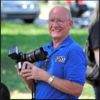Settings for Indoor flash with overhead flourescent lighting
Feb 2, 2019 19:03:43 #
foxfirerodandgun
Loc: Stony Creek, VA
I will be called on to take pictures of our church's Valentine Banquet. I will be using a D7200 with a SB-800 flash unit. The fellowship hall is fairly large with 12, two tube overhead florescent light fixtures. What settings for the flash unit & camera would anyone suggest useing. It will be at night so there will be no outside lighting to contend with. I haven't had really good results in the past with this setup used in this environment. The distances may be up close to 20 to 30 feet away and I will be mobile / no tripod. I've spot read the manual, and a SB-800 "cheat sheet" but do not feel confident with what I've read. Thanks for any & all suggestions that anyone would care to share.
Feb 2, 2019 19:33:59 #
foxfirerodandgun wrote:
I will be called on to take pictures of our church... (show quote)
What lens would you be using?
I would get to the banquet early and try different settings. If you haven't had much luck with your flash I would try auto. Generally I would shoot manual but to be save auto. I would also try no flash, up the iso shoot manual and play with your settings before the event.
Good luck.
Feb 2, 2019 19:35:55 #
The only suggestion I or anybody can offer is...when you get a chance, go to the Banquet Hall during the day or night and practice shooting with the lights on.
Feb 2, 2019 20:11:46 #
Start at ISO 100-200, f/5.6 to f/7.1 and 1/125 to 1/200 and see if this will kill all the ambient light. Then your flash will be providing all the light if you kill the ambient light. If your flash is not powerful enough to shoot the longer distance shots with these settings you may have to use some of the existing fluorescent ambient light as part of your exposure. Perhaps increasing your ISO to do it. The fluorescent light will likely be at a different Kelvin temp than your flash. Many flashes are close to daylight white balance. You would probably need to tell your flash to match the flash light to the in room fluorescent light. I am sure you can find some YouTube videos to help you out. And experiment beforehand if you can.
Best,
Todd
Best,
Todd
Feb 2, 2019 20:23:54 #
I would also agree with a trial shoot if possible, but in many cases like this, I've found post processing control of white balance to be my best friend.
Andy
Andy
Feb 2, 2019 20:32:57 #
My SB700 flash comes with an incandescent and fluorescent light correction filter. I've used the incandescent filter to color correct a light. The filters have tangs on them that depress switches on the SB700. The flash reads the position of the switches and "knows" which filter is attached. It sends that information to the camera. If the camera is set on auto or flash white balance, it will automatically apply the correct white balance. I did these shots.
The SB800 comes with those filters.
The SB800 comes with those filters.
Notice the warm light from the light fixture
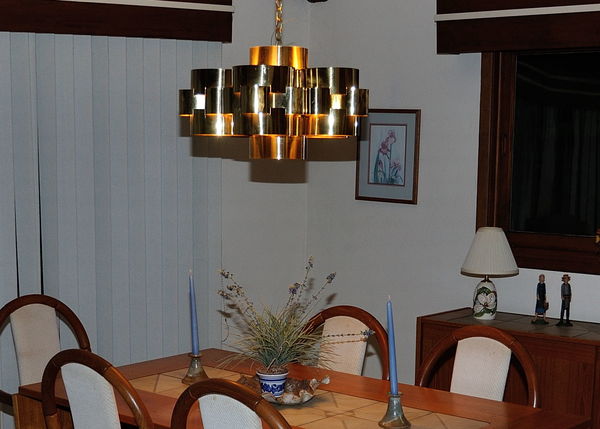
(Download)
The incandescent filter bathes the scene with amber colored light
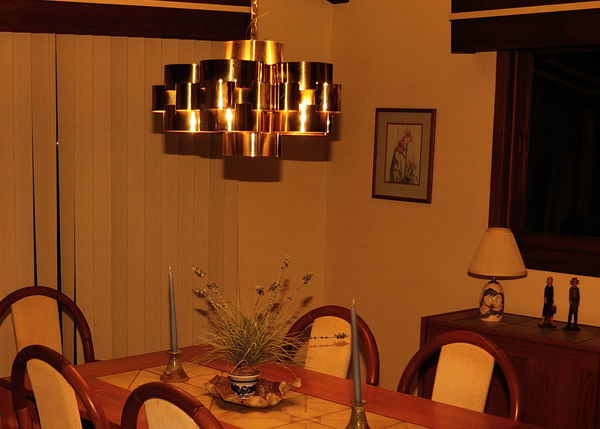
(Download)
Notice that the warm light from the incandescent bulb in the light fixture has been neutralized
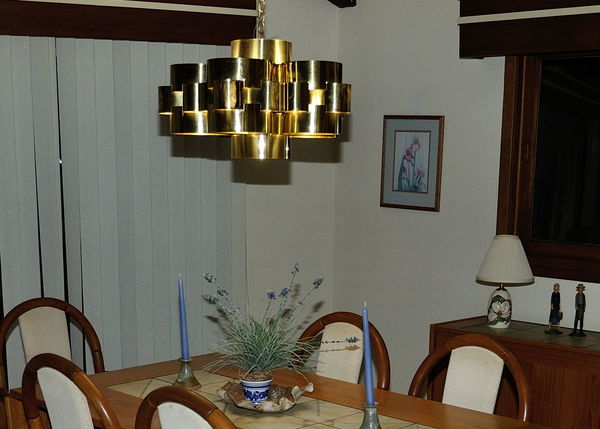
(Download)
Tangs on the filters depress switches on the SB700. The flash reads the position of the switches and sends that information to the camera
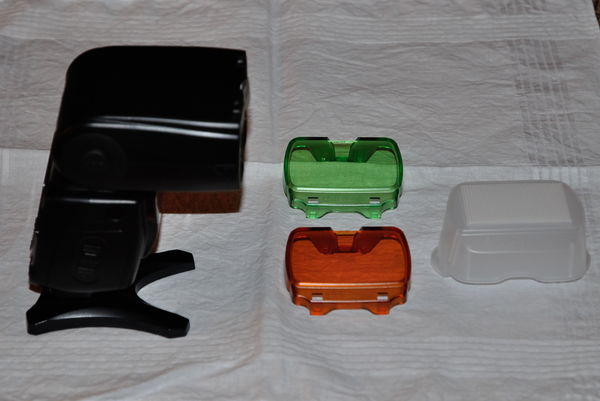
(Download)
Feb 2, 2019 20:39:50 #
larryepage
Loc: North Texas area
Flash output is usually somewhere around 5000K. Most fluorescent tubes are around 3700-4000 and also have some tint on the magenta - yellow axis which is different from the color temperature axis, although some newer choices come close to 5000K. Most churches, including mine, buy fluorescent tubes with traditional "cool white" output for the simple reason that they are about half the cost of other choices.
All that to say that you can probably match either of the light sources, but will almost certainly get different results when doing closer shots than those at the 20-30 foot range that you mention. I have an SB-800, and it does not have enough power to be the dominant light at that distance. I don't recall that my SB-800 included a fluorescent filter, or that I still have it if it did. If so, that would obviously be the best solution.
You do not say how much post processing you are planning to do, but you can always fix the problem there. Otherwise I'd try to group the closer shots and the longer shots, using flash WB for the former and fluorescent for the latter. If, as suggested above, you can get into the space early and experiment, you might find that you get lucky and the problem in reality is not as bad as we are fearing.
Good luck as you work to a solution.
All that to say that you can probably match either of the light sources, but will almost certainly get different results when doing closer shots than those at the 20-30 foot range that you mention. I have an SB-800, and it does not have enough power to be the dominant light at that distance. I don't recall that my SB-800 included a fluorescent filter, or that I still have it if it did. If so, that would obviously be the best solution.
You do not say how much post processing you are planning to do, but you can always fix the problem there. Otherwise I'd try to group the closer shots and the longer shots, using flash WB for the former and fluorescent for the latter. If, as suggested above, you can get into the space early and experiment, you might find that you get lucky and the problem in reality is not as bad as we are fearing.
Good luck as you work to a solution.
Feb 2, 2019 21:25:54 #
When in doubt, bring extra light.
BTW, exposure isn't the only issue: those fluorescent lights may have poor color reproduction
(there's no telling, it depends on the tube--some are pretty good, some are awful). Color temperature
is easy to fix in processing, but color reproduction problems usually are unfixable.
Once again, the solution is to bring an extra flash and stand, so you can bounce some flash
off the ceiling. But in a pinch, even cheap clip-on reflector lamps with incandescent bulbs
and extensions chords are better than nothing. Anything that makes continuous spectrum light
will improve color reproduction.
Any camera filter (optical or digital) that claims to "fix" fluorescent lighting is a liar. All it can do is
correct for color temperature. But a filter on a flash (a continuous spectrum source) makes a
lot of sense!
Color Reproduction Rhyme
Sodium vapor is favored today:
Street light that's bright, efficient and mellow
That's why roses are gray, violets are gray
And sugar is yellow.
BTW, exposure isn't the only issue: those fluorescent lights may have poor color reproduction
(there's no telling, it depends on the tube--some are pretty good, some are awful). Color temperature
is easy to fix in processing, but color reproduction problems usually are unfixable.
Once again, the solution is to bring an extra flash and stand, so you can bounce some flash
off the ceiling. But in a pinch, even cheap clip-on reflector lamps with incandescent bulbs
and extensions chords are better than nothing. Anything that makes continuous spectrum light
will improve color reproduction.
Any camera filter (optical or digital) that claims to "fix" fluorescent lighting is a liar. All it can do is
correct for color temperature. But a filter on a flash (a continuous spectrum source) makes a
lot of sense!
Color Reproduction Rhyme
Sodium vapor is favored today:
Street light that's bright, efficient and mellow
That's why roses are gray, violets are gray
And sugar is yellow.
Feb 2, 2019 21:34:08 #
foxfirerodandgun
Loc: Stony Creek, VA
Jules Karney wrote:
What lens would you be using?
I would get to the banquet early and try different settings. If you haven't had much luck with your flash I would try auto. Generally I would shoot manual but to be save auto. I would also try no flash, up the iso shoot manual and play with your settings before the event.
Good luck.
I would get to the banquet early and try different settings. If you haven't had much luck with your flash I would try auto. Generally I would shoot manual but to be save auto. I would also try no flash, up the iso shoot manual and play with your settings before the event.
Good luck.
I'll have considered using a Nikkor 18-200mm, 3.5-5.6 DX lens. However, I do have a couple kit lens 18-70mm, 3.5-4.5G DX (Thailand) which may be a better focal range, and a 55-200mm, 1:4-5.5G (China).
Feb 2, 2019 21:39:16 #
foxfirerodandgun
Loc: Stony Creek, VA
CO wrote:
My SB700 flash comes with an incandescent and fluo... (show quote)
The only filter that came with either of my SB-800's was one TN-A1 which appears to be for incandescent lighting.
Feb 2, 2019 22:29:44 #
Feb 3, 2019 06:29:16 #
tcthome
Loc: NJ
Ched49 wrote:
The only suggestion I or anybody can offer is...when you get a chance, go to the Banquet Hall during the day or night and practice shooting with the lights on.
The church owns the hall? Go there this week & experiment. Read your camera & flash manuals. My sb700 came with filters for incandescent & florescent lights. Bring some people with you & practice. If need be write down the settings in a note pad. You camera might let you doa custom settings menu save you can name night florescent. If you can dial in the flash (more or less power for good exposures) you can shoot raw & correct the white balance in post if need be. But your going to need practice. watch some flash vids on you tube. Good luck. Some links.
https://www.youtube.com/watch?v=9ln-
0M8FxH0&index=44&list=PLOD1rrjm5sQDgYkCjzsN9nCdHOPa4l1ES&t=0s
https://www.youtube.com/watch?v=c-FR7Ou25IE&list=PLOD1rrjm5sQDgYkCjzsN9nCdHOPa4l1ES&index=35&t=0s
Feb 3, 2019 06:30:27 #
foxfirerodandgun wrote:
The only filter that came with either of my SB-800's was one TN-A1 which appears to be for incandescent lighting.
I was reading on the internet that the SB800 comes with both filters but maybe only the TN-A1 filter comes with it. You could probably purchase the FL-G1 online. I saw this Nikon guide for the SB800 online.
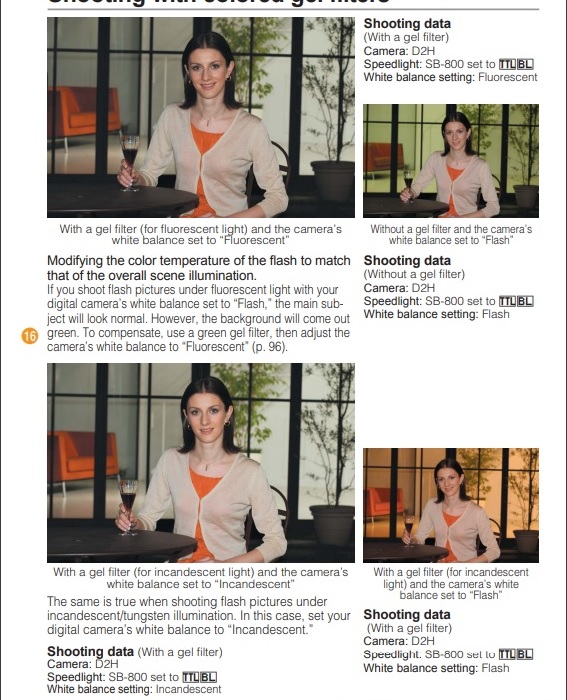
Feb 3, 2019 07:36:10 #
I shoot a lot of events in this type of environment. My basic settings are, shutter - 125, aperture - f/4 to f/5.6, ISO 800 to 1600, with auto white balance. If the fluorescent lighting is affecting my photos I change my White balance to K (Kelvins) and dial in a number that gives me the results I am happy with, usually around 2500 to 3500. I use TTL flash and have my flash turned down -1/3 stop so as to not blow out the faces. Don't be worried about turning up the ISO with flash. I adjust my ISO this way, I set my camera up as mentioned above except with auto ISO and flash turned off. I take a photo and see what my camera set the ISO. Then I turn on my flash and divide that ISO in half and adjust from there.
Feb 3, 2019 08:17:13 #
Jules Karney wrote:
What lens would you be using?
I would get to the banquet early and try different settings. If you haven't had much luck with your flash I would try auto. Generally I would shoot manual but to be save auto. I would also try no flash, up the iso shoot manual and play with your settings before the event.
Good luck.
I would get to the banquet early and try different settings. If you haven't had much luck with your flash I would try auto. Generally I would shoot manual but to be save auto. I would also try no flash, up the iso shoot manual and play with your settings before the event.
Good luck.
How about Program Mode??
If you want to reply, then register here. Registration is free and your account is created instantly, so you can post right away.





